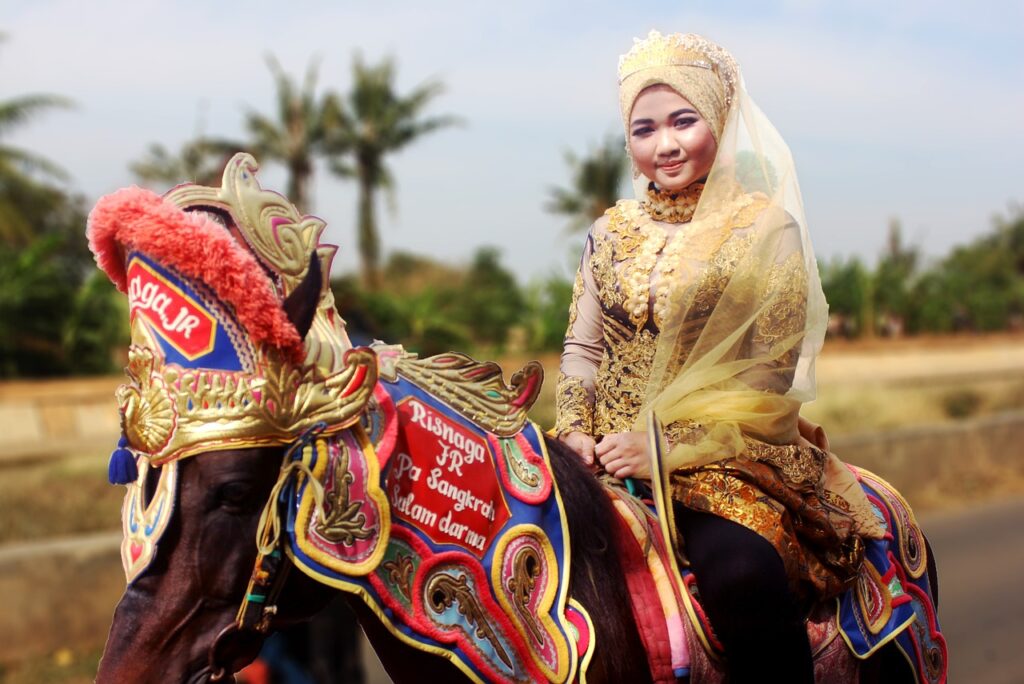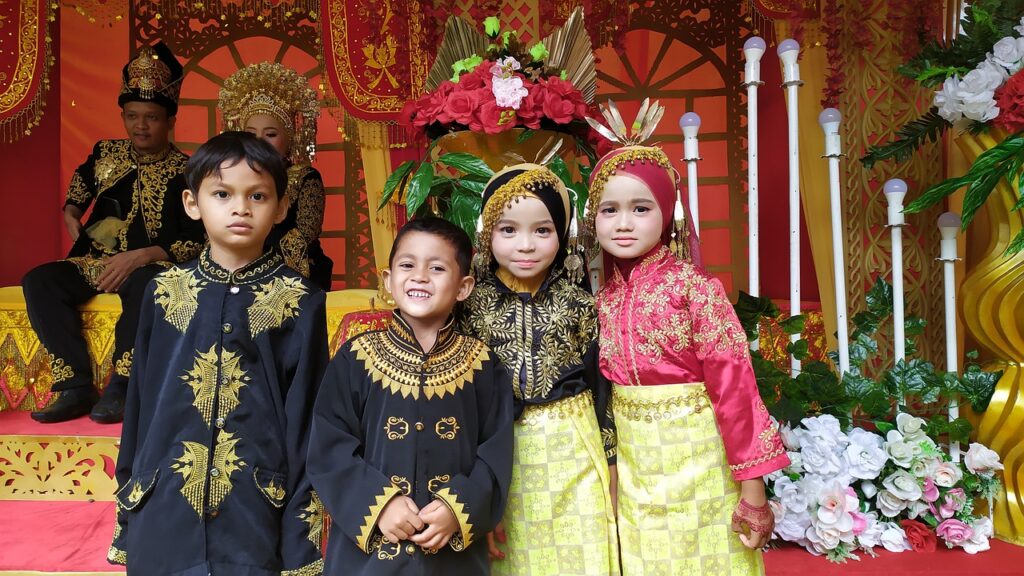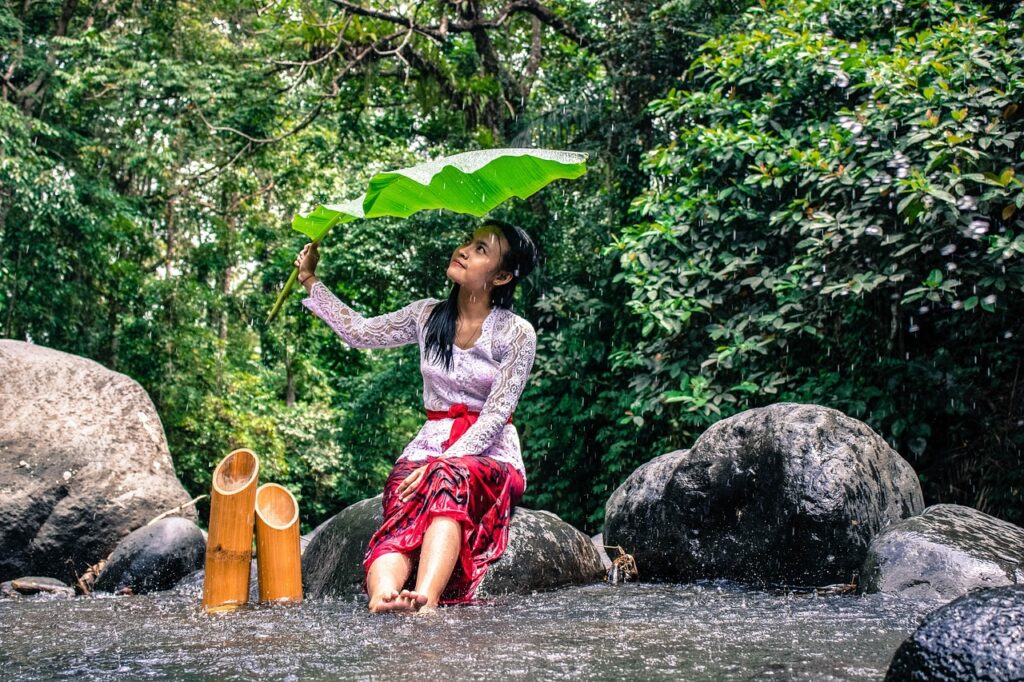Indonesia, officially known as the Republic of Indonesia, is a sprawling nation located in Southeast Asia and Oceania.
Its geographic expanse encompasses over 17,000 islands, including major ones like Sumatra, Java, Sulawesi, and portions of Borneo and New Guinea.
Remarkably, Indonesia ranks as the world’s largest island country and occupies the 14th spot in terms of land area, covering approximately 1,904,569 square kilometers (735,358 square miles).
What sets Indonesia apart is its status as the fourth most populous country worldwide and the most heavily populated Muslim-majority nation. With more than 278 million people, it’s a mosaic of cultures, languages, and traditions.
Central to Indonesia’s diverse identity is Java, the world’s most populous island, home to over half of the nation’s inhabitants.
Indonesia functions as a presidential republic with a democratically elected legislature. Its administrative divisions include 38 provinces, nine of which hold special status.
The bustling metropolis of Jakarta, serving as the nation’s capital, stands as the world’s second-most populous urban area.
Diversity in Indonesian Traditional Clothing

Indonesia, the world’s largest island nation comprising over 70,000 islands, is a cultural mosaic where tradition and diversity harmoniously coexist.
With more than 30 provinces, each boasting its own unique and captivating Indonesian traditional clothing, Indonesia offers a drapery of cultural expressions that reflect its rich heritage.
Despite centuries of influence from religions like Christianity, Islam, Confucianism, Buddhism, and Hinduism, numerous indigenous cultures have persevered.
Indonesian traditional Clothing is a reflection of its diverse cultural landscape, where age-old traditions meet contemporary interpretations, weaving a captivating narrative of history and heritage.
Whether you’re drawn to the profound symbolism of Batik or the daily elegance of Udeng, these iconic attires invite you to explore Indonesia’s rich cultural heritage.
Indonesian Traditional Clothing: 11 Types
1. Kebaya
The Kebaya, a blend of blouse and dress, traces its roots to the Majapahit Kingdom, a precursor to modern-day Indonesia.
A symbol of grace, it is the traditional attire of Indonesian women, notably among the Balinese, Sundanese, and Javanese.
Beyond Indonesia, the Kebaya graces the Philippines, Cambodia, Thailand, Brunei, Singapore, and Malaysia. Originally designed to render the aristocratic Kemban (torso wrap) more suitable for Islamic modesty, the Javanese Kebaya later found resonance in Johor, Riau, and Aceh. Crafted from delicate materials like silk, polyester, or fine cotton, it is adorned with intricate floral-patterned embroidery.
Kebaya is a blend of sophistication and heritage; it was initially worn by aristocrats. It gracefully drapes the upper body and pairs it with a straight-lined skirt crafted from Indonesian traditional clothing-woven fabrics like batik or songket.
Adorned with floral embroidery, brooches, and ornate head accessories, Kebaya has evolved, offering contemporary interpretations while staying true to its rich legacy.
2. Batik
Batik, a source of national pride, captivates with its intricate patterns and profound philosophical significance. This beloved Indonesian cloth is celebrated not only for its aesthetic charm but also for the historical and symbolic meanings embedded in each pattern.
The creation of batik is a laborious process, emphasizing the artistic prowess of handcrafted design.
To bring these patterns to life, artists employ the precise technique of drawing with a pencil, followed by re-creation using hot wax through an instrument called a “canting.”
3. Peci
The Peci, also known as Kopiah or Songkok, is the iconic headgear adorning Muslim men in Indonesia, as well as in Thailand, the Philippines, Singapore, Malaysia, and Brunei.
Resembling the Egyptian-Turkish fez, the black velvet Peci holds the status of a national headdress, a legacy of Sukarno’s influence.
Activists of Indonesia’s nationalist movements, including luminaries like Agus Salim, Muhammad Hatta, and Sukarno, donned the Peci in their quest for national identity and independence.
It remains an indispensable part of the official attire for all male Indonesian presidents.
4. Jarik
Every Indonesian seems to possess a jarik, an essential Batik cloth that plays a versatile role in daily life. This adaptable fabric is a part of Indonesian daily life, serving as an undergarment, a baby carrier, a baby’s sleeping base, formal attire, and more.
The patterns on a Jarik can even signify the wearer’s status, adding a layer of symbolism to its practicality.
5. Kemben
Kemben is a traditional torso wrap primarily embraced by women in Bali and Java. Historically, it entailed wrapping a piece of cloth around the torso, securing it, folding it, tying it with a rope, and concealing it under an angkin.
Modern times have seen the emergence of tailored Kemben fastened with zippers, straps, or buttons akin to Western corsets.
Kemben stands as a hallmark of comfort in Indonesia’s humid climate, facilitating perspiration and ventilation. Before the advent of the Kebaya, it was the prevailing and popular choice of attire for Javanese women.
6. Songket
Songket, a traditional fabric indigenous to Sumatra, stands out with its exquisite handwoven composition of silk or cotton adorned with threads of gold or silver.
This intricate fabric was historically considered a luxury item, reserved for special occasions like weddings, religious ceremonies, and cultural rituals. Today, fashion designers draw inspiration from Songket to create contemporary pieces that celebrate this sumptuous tradition.
7. Baju Kurung
Baju Kurung, the enclosed dress, is celebrated as Malaysia’s national attire. However, it is also a significant regional dress across the ethnically and culturally diverse nation, with roots extending to Sumatra Island.
Historically looser and lengthier, Sultan Abu Bakar of Johor introduced the modern iteration during the 19th century. It underwent a revival in the 1970s and 1980s amid Malaysia’s Islamization.
While the term encompasses attire for both genders, Baju Kurung predominantly refers to female dress in Malaysia.
8. Blangkon
Blangkon, a traditional male headdress widely embraced by Javanese men, is crafted from batik fabric and boasts four distinctive types based on origin and shape: Banyumasan, Kedu, Surakarta, and Ngayogyakarta.
The story of Blangkon is steeped in legend, with some attributing its origin to Aji Saka, the figure believed to have defeated the giant who once ruled Java.
Saka is also associated with the creation of the Javanese calendar. Alternative theories point to Islamic and Hindu influences on Javanese culture.
The inspiration behind Blangkon may be traced to the turbans worn by Gujarati traders, among the earliest Muslims to visit Java. Blangkon showcases the vibrant fusion of Islamic and Hindu influences within Javanese culture.
Made from Batik fabric, Blangkon has become an iconic collectible for tourists and a symbol of Javanese heritage.
9. Suntiang
Suntiang is an opulent accessory worn by Minangkabau brides, symbolizing their commitment and responsibility as wives. Crafted from real gold and aluminum, Suntiang features up to seven levels of exquisite floral and fauna decorations.
Despite its considerable weight—up to seven kilograms—brides proudly bear this headdress throughout their special day.
The grand design of Suntiang embodies the profound message of marital responsibility and never fails to earn admiration from onlookers.
10. Ulos
Ulos, a handwoven fabric originating from Batak, North Sumatra, is reserved for ceremonial use. This shawl-like attire is not only a cultural treasure but also carries immense familial significance.
Often handed down through generations, Ulos is adorned with intricate golden or silver threads that add to its allure. Today, Ulos has transcended its ceremonial roots and become popular as cultural souvenirs, appearing in various forms such as bags, clothing, belts, tablecloths, and ties.
11. Udeng
Udeng is the headdress worn by Balinese men in their daily lives. It serves as both a mark of respect for their culture and a practical way to keep their hair in order.
The color and shape of Udeng carry meaning, representing social status and serving as a ceremonial attribute.
For those seeking a tangible connection to Bali’s vibrant culture, Udengs can be found in local souvenir stores, offering an opportunity to embrace the island’s traditions.
The Geography of Indonesia

This extensive archipelago shares land borders with Papua New Guinea, East Timor, and the eastern part of Malaysia. It also boasts maritime boundaries with neighboring countries like Singapore, Vietnam, Thailand, the Philippines, Australia, Palau, and India.
While Indonesia’s population is immense and its regions densely populated, it still contains vast expanses of wilderness known for its exceptional biodiversity.
History and Heritage of Indonesia
The history of Indonesia is woven with tales of early trade routes, influence from Indian and Chinese civilizations, Hindu and Buddhist kingdoms, and the eventual spread of Islam.
Following Dutch colonial rule, Indonesia embarked on a journey to independence after World War II, marked by a tumultuous history characterized by natural disasters, political challenges, economic transformations, and cultural diversity.
Today, Indonesia stands as a melting pot of thousands of native ethnic groups, each contributing to the motto “Bhinneka Tunggal Ika,” or “Unity in Diversity.”
The nation’s rich heritage is embodied through its national language, diverse cultures, religious pluralism within its Muslim-majority populace, and a history marked by resistance against colonial rule.
Indonesia’s economy is globally recognized, ranking as the 16th largest by nominal GDP and the 7th largest by purchasing power parity.
It is a democratic regional powerhouse and plays a significant role in international affairs as a middle power. Indonesia is a member of several prestigious international organizations, further reinforcing its global presence.
Significance of Indonesian traditional clothing
Indonesia, with its diverse culture and extensive archipelago, is a land where traditional clothing is more than just fabric; it’s a reflection of history, heritage, and identity.
When we think of Indonesia, images of vibrant Batik patterns, exquisite Kebaya attire, and iconic Peci headdresses often come to mind.
However, what many don’t realize is that Indonesia boasts a mosaic of over 30 provinces, each with its own unique traditional clothing, providing a captivating drapery of culture and history.

1. ELEGANCE
Indonesian traditional clothing can be divided into three primary categories: batik, kebaya, and sarong. These iconic attires are deeply rooted in the Javanese, Sundanese, and Balinese cultures.
Batik, recognized as a UNESCO-protected intangible cultural heritage, is renowned for its intricate patterns and exquisite craftsmanship.
Batik shirts and Kebaya attire are staples of formal occasions, with patterns that vary by region, revealing stories of Indonesia’s diverse heritage.
2. NOBILITY OF MASCULINITY
Just as Batik represents Indonesian culture, the Peci (or Songkok) signifies the identity of Muslim men. This black cap, with connotations akin to the Turkish fez, has become the formal national headwear for Indonesian men, including government officials and presidential figures.
Notable personalities like Sukarno, Indonesia’s first president, played a role in popularizing the Peci.
3. GRACEFULNESS OF WOMEN
The Kebaya, traditionally worn by Javanese, Sundanese, and Balinese women, has transcended regional boundaries to become a national treasure.
This exquisite long-sleeved blouse, often paired with a batik sarong, reflects the evolution of traditional attire in Indonesia.
Today, while many women continue to embrace the traditional bun and ornate hairpins, there’s a growing trend of Muslim women opting for head coverings like the hijab.
4. REGIONAL DIVERSITY
Indonesia’s ethnic diversity is beautifully expressed through regional outfits known as “Baju Adat” or “Baju Daerah.” These attires represent the distinct cultural groups within the country.
Each area features unique headgear and headdresses, such as the Balinese Udeng and the Javanese Blangkon. The motifs, folding techniques, and styles differ across Indonesia’s vast landscape.
5. CULTURAL WEALTH
Indonesia’s traditional dancers dazzle with vibrant costumes adorned with golden ornaments. The Balinese and Javanese dancers wear the magnificent crown called “Jamang,” with roots tracing back to the Hindu-Buddhist era.
In Sumatra, brides don the “Suntiang,” distinct from the Javanese “Jamang.”
These crowns have deep cultural and historical significance, and they play a vital role in traditional dances and ceremonies.
7. EVENTFULNESS
Traditional textiles hold a special place in Indonesian culture. From intricate Batik patterns to shimmering Songket fabrics, these textiles play a pivotal role in various life events and ceremonies.
Different regions have their own materials, techniques, colors, and designs that carry specific meanings.
The use of textiles varies for birth, circumcision, puberty, marriage, childbearing, and death ceremonies.
Indonesia’s traditional clothing isn’t just a relic of the past; it’s a living heritage that plays a central role in the country’s celebrations and rituals.
Weddings, religious ceremonies, and cultural festivals are opportunities for Indonesians to proudly don their traditional attire. The choice of clothing reflects the significance of the event and pays homage to the cultural diversity within the country.
8. ADAPTABILITY
Indonesian fashion seamlessly blends tradition with modernity. Renowned designers such as Tex Saverio and Biyan Wanaatmadja have created awe-inspiring collections inspired by traditional fabrics and costumes.
Their work showcases the adaptability of traditional clothing in contemporary fashion.
9. PRESERVING THE LEGACY
Taman Mini Indonesia Indah, located in Jakarta, boasts an extensive collection of traditional Indonesian costumes, providing a comprehensive representation of each region and ethnic group.
The museum’s exhibits are a testament to Indonesia’s rich sartorial heritage, offering visitors an opportunity to explore the nation’s diverse cultural identities.
10. EVERYDAY ELEGANCE
Beyond formal occasions and ceremonies, traditional clothing finds its place in everyday life. For instance, Indonesian men often wear the baju koko on religious occasions, paired with a sarong and a peci.
In Sumatra, women prefer the Baju Kurung, a Malay-style tunic. In South Sulawesi, Bugis women don the traditional Baju Bodo with short sleeves.
At home, Indonesian women opt for comfortable and loose dresses called dasters. In recent years, there’s been a growing trend of Muslim women choosing to cover their hair and neck with a veil, jilbab, or hijab.
11. ARTISTIC CRAFTINESS
The creation of traditional Indonesian clothing is a labor-intensive and artistic process. Skilled artisans handcraft these garments with intricate details and exquisite designs.
The mastery of techniques like batik, songket weaving, and kat dyeing has been passed down through generations. Some rural communities still rely on traditional methods, emphasizing the importance of preserving these crafts.
12. EXPRESSIVE PATTERNS
Traditional clothing in Indonesia is often adorned with symbolic patterns and motifs. These designs are more than just aesthetics; they carry deep cultural and spiritual meanings.
For example, on the island of Bali, the Barong pattern represents good spirits, while the Rang-Rang pattern is associated with protection. Understanding these patterns adds another layer of appreciation to the beauty of Indonesian traditional clothing.
13. A BRIDGE TO THE PAST
Indonesia’s historical reenactments often feature traditional clothing, providing a visual link to the past.
These events showcase the evolution of Indonesian culture and offer a fascinating perspective on how clothing has evolved over the centuries.
From ancient royal courts to colonial periods, traditional attire brings history to life.
14. CULTURAL FUSION
Beyond high fashion, the fusion of traditional Indonesian clothing with contemporary wear is also seen on the streets. Modern interpretations of Indonesian traditional clothing elements are not only stylish but also a testament to the enduring relevance of Indonesia’s cultural heritage.
Young Indonesians are embracing their roots with pride and incorporating traditional pieces into their everyday wardrobes.
15. GLOBALIZATION
Indonesia’s traditional clothing has transcended its borders and made its mark on the global stage. From runways in Paris to international cultural festivals, traditional Indonesian attire has been celebrated worldwide.
Batik, in particular, has found a global audience and is admired for its artistic value and cultural significance.
16. EDUCATIONAL INITIATIVES AND CULTURAL PRESERVATION
Government and non-governmental organizations in Indonesia are taking steps to preserve traditional clothing. Educational initiatives are helping young Indonesians learn about their heritage and the significance of traditional attire.
Museums, like the Museum Taman Mini Indonesia Indah in Jakarta, provide a tangible link to the past and promote cultural preservation.
17. THE CONTINUOUS STORY
Indonesian traditional clothing tells a story that is still being written. As the nation continues to evolve, so too does its clothing.
This living history reflects the dynamic nature of Indonesian culture, where tradition and modernity coexist harmoniously.
Indonesian traditional clothing is not just a relic of the past; it’s a vibrant part of the nation’s identity, cherished and celebrated by its people.
Conclusion
Indonesian traditional clothing is a vibrant expression of its cultural diversity, history, and identity. These Indonesian traditional clothing textiles and attires continue to evolve, adapting to contemporary fashion while preserving the rich heritage they represent.
The nation’s commitment to preserving and promoting these traditions ensures that Indonesian traditional clothing remains a timeless and cherished aspect of the country’s cultural identity.




